Sexual Reproduction In Flowering Plants Very Short Question And Answers
Question 1. The hilum in a typical angiosperm ovule represents the junction between –
- Integuments and the embryo sac.
- Embryo sac and its ocellus
- The body of the ovule and the funicle
- Nocellus and the funicle
Answer: 3. Body of the ovule and the funicle.
Question 2. In the given diagram of a transverse section of a young amber Choose the labelling showing the correct placement of the wall layers from the table given below.
Answer:
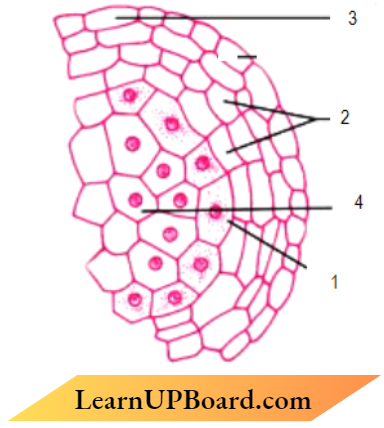
class 12 biology chapter 2 important questions and answers

- Tapetum
- Endotliecium
- Epidermis
- Middle layers
Read and Learn More Important Questions for Class 12 Biology Chapter Wise
Question 3. The term used for the embryo entering into the state of inactivity as the seed matures is
- Quiescent
- Parthenogenesis
- Parthenocarpy
- Donnancy
Answer: 4. Dormancy
Question 4. The ploidy of the apomictic embryo developed from the integument cells and megaspore mother a cell without reduction division respectively will be
- 2n and 2n
- n and n
- 2n and n
- 3n and 2n
Answer: 1. 2n and 2n
Question 5. Below is a diagrammatic representation of a mature embryo sac of a typical angiosperm plant. Choose the option showing the correct labelling for the parts W, X, Y and Z from the table below.
Answer:
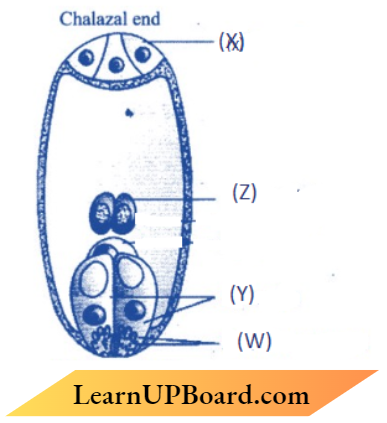
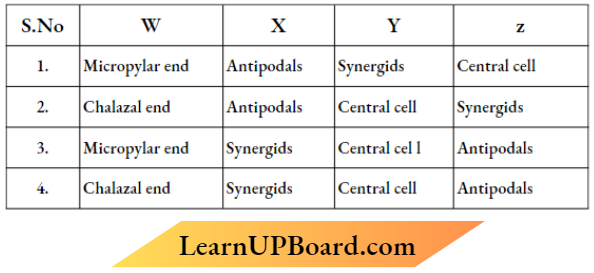
reproduction in flowering plants class 12 questions and answers
Answer: 3. Y – Micropylar end. X – Antipodals, Y-Synergids, Z – Central cell
Question 6. Given below is a figure of an angiosperm plant showing two different types of flowers ‘X’ and the possible type of pollination in them :
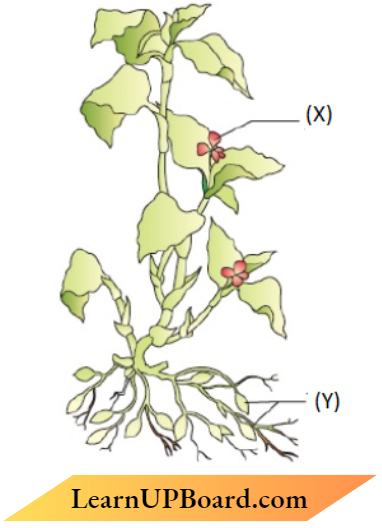
Select the correct option for the flower (X) and flower (Y) and the possible type of pollination from the given table:

Answer: 3. Flower X Chasmogamous self Or cross-pollination Flower Or Cleistogamous, self-pollination
Question 7. An undifferentiated sheath covering the root cup of a monocotyledonous embryo is:
- Scutellum
- Coleorhiza
- Coleoptile
- Epi blast
Answer: 2. Coleorhiza
Question 8. Residual persistent nucellus in black pepper is known as :
- Perisperm
- Pericarp
- Putvinus
- Perianth
Answer: 1. Perisperm
Question 9. Amongst tile insects, the dominant biotic pollinating agents are –
- Ants
- Wasps
- Beetles
- Bees
Answer: 4. Bees
Question 10. A genetic mechanism which prevents inbreeding depression in the majority of atigiospenu plants is
- Parthenogenesis
- Parthenoeurpy
- Mutation
- Self-incompatibility
Answer: 3. Self-incompatibility
” reproduction in flowering plants questions and answers pdf class 12″
Question 11. Self-pollination is fully ensured if
- The flower is bisexual.
- The style is longer than the filament.
- The flower is cleistogamous.
- The time of pistil and another maturity is different.
Answer: 3. The flower is cleistogamous.
Question 12. Some flowers, selected for artificial hybridization, do not require emasculation but bagging is essential for them. Give a reason.
Answer:
As some Bowers are unisexual, to prevent contamination of their stigma with unwanted pollen grains.
Question 13. Write one advantage and one disadvantage of cleistogamy to flowering plants.
Answer:
Cleistogamy Advantage:
Assured seed set maintains pure lines.
Cleistogamy Disadvantage:
No variation or only parental characters are preserved or it can lead to inbreeding depression.
Sexual Reproduction In Flowering Plants Short Question And Answers
Question 1:
1. Write the two crucial changes the seeds undergo while reaching maturity that enable them to be in a viable state until the onset of favourable conditions.
Answer:
Seeds remain in a state of dormancy-induced desiccation and the hormone abscisic acid until conditions for growth become favourable.
2. Name the oldest viable seed excavated from the Arctic Tundra as per the records.
Answer:
The oldest is that of a lupine, Lupinus an excavated front Arctic Tundra.
Question 2. Explain the mechanism of pollination in marine seagrasses like Zostcra.
Answer:
In marine Seagrasses, female flowers remain submerged in water and the pollen grains are released inside the water. Pollen grains in many such species are long, ribbon and they are carried passively inside the water; some of them reach the stigma and achieve pollination.
Question 3. What is ‘bagging’? State its importance in the artificial hybridization of flowering plants.
Answer:
Bagging – Process of covering emasculated or female or artificially pollinated flowers with a bag of suitable size generally made up of butter paper (to prevent contamination of stigma with unwanted pollen).
Importance – The desired pollen grains are used for pollination or the stigma is protected from contamination from unwanted pollen. It combines desirable characteristics to produce commercially superior varieties.
Question 4:
1. You are given castor and bean seeds. Which one of the two would you select to observe the endosperm?
Answer:
Castor
2. The development of endosperm precedes that of embryos in plants. Justify.
Answer:
Endosperm stores reserve food materials or provide nutrition to the developing embryo.
Question 5. Write any two ways by which apomictic seeds may be developed in angiosperms.
Answer:
- Develops from a diploid egg cell (formed without reduction division) which grows into an embryo without fertilization.
- Develops from the nuclear cell which divides and protrudes into the embryo sac and develops into an embryo
Question 6. A pollen grain in angiosperm at the time of dehiscence from an anther could be 2-celled or 3-celled. Explain. Mow arc the cells placed within the pollen grain when shed at a 2-celled stage?
Answer:
- In the 2-celled stage, the mature pollen grain contains a generative and vegetative cell, whereas in the 3- 3-celled stage one vegetative cell and two male gametes are present.
- The generative cell floats in the cytoplasm of the vegetative cell.
Question 7:
1. When a seed of orange is squeezed, many embryos, instead of one are observed. Explain how it is possible.
Answer:
Polyemhryony and nucellar cells surrounding the embryo sac start dividing, protrude into the embryo sac and develop into many embryos.
class 12 biology chapter 2 important questions pdf download
2. Are these embryos genetically similar or different? Comment.
Answer:
These embryos are genetically similar, as produced from nucellar cells by mitotic division/formed without fertilisation (but different from the embryo formed by fertilization)
Question 8. Draw a schematic transverse section of a mature anther of an angiosperm. Label its epidermis, middle layers, tapetum, eudothecium, sporogenous tissue and the connective.
Answer:
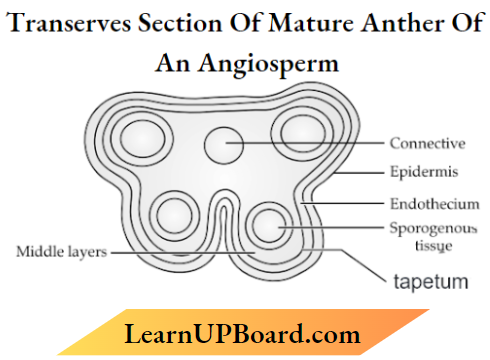
Question 9. Differentiate between wind-pollinated and insect-pollinated flowers.
Answer:
Wind pollinated: Pollen grains are light sticky or well-exposed stamens or Large feathery stigmas or single ovule in each flower or Small flowers packed in inflorescence.
Insect pollinated: Pollen grains sticky or Moral rewards or Fragraut or Neetar rich or Large Flower.
Question 10:
1. When and where do tapetum and synergids develop in (lowering plants? Mention their functions.
Answer:
- Tapetum – Mierosporogenesis. Microsporang (Anther), nourishes the developing pollen grains.
- Synergids – Megusporogenesis. Megasporangiumtovule), synergids have filiform apparatus to guide the pollen tube into it.
2. Where are the following structures present in a male gametophyte of an angiosperm? Mention the function of each one of them.
- Germ pore
- Sporopollenin
- Generative cell
Answer:
- Germ pore- Pollen grain exiting, site from where pollen tube emerges.
- Sporopollenin – Exine of the pollen grain, protects the pollen grains from high temperature and strong acids And alkalis or enzymes or adverse conditions.
- Generative cells – Pollen grains give rise to two male gametes.
Question 11. Draw L.S. of an embryo of grass and label its parts.
Answer:
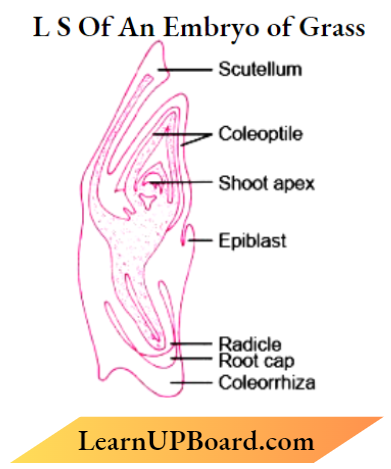
Question 12. Draw a labelled diagram of a mature male gametophyte of an angiosperm.
Answer:
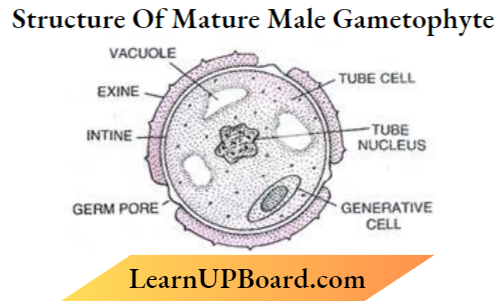
Question 13. Do you think apomixis can be compared with asexual reproduction? Support your answer, by giving one reason. Flow is apomixis beneficial to farmers? Explain.
Answer:
Yes, seeds are produced without fertilisation.
Production of hybrid seeds is costly, if hybrids with desirable characteristics can be made into apomicts, there is no segregation of characters in the hybrid progeny, and farmers can continue using hybrid seeds year after year and do not have to buy hybrid seeds.
Question 14:
1. Can a plant flowering in Mumbai be pollinated In pollen grains of the same species growing in New Delhi? Provide explanations for your answer.
Answer:
Yes. Artificial hybridisation in pollen grains of the flower is introduced artificially on the stigma of another flower.
2. Draw the diagram of a pistil where pollination has successfully occurred. Label the parts involved in reaching the male gametes to their desired destination.
Answer:
Diagram with following labelling Stigma, Pollen tube, Synergid or Filiform Apparatus. Micropyle
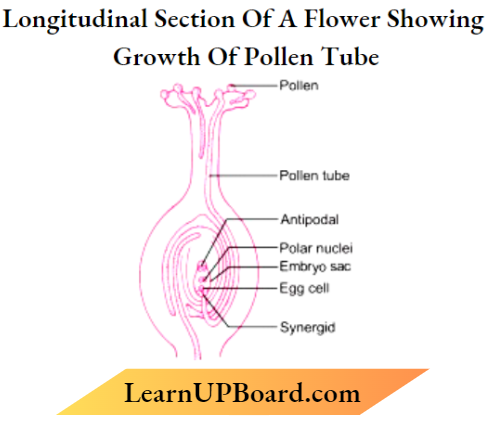
Question 15:
1. Draw a diagram of Pistil showing pollen tube growth in angiosperm and label
- Stigma
- male gametes
- micropyle end
- Ovule.
Answer: 1.
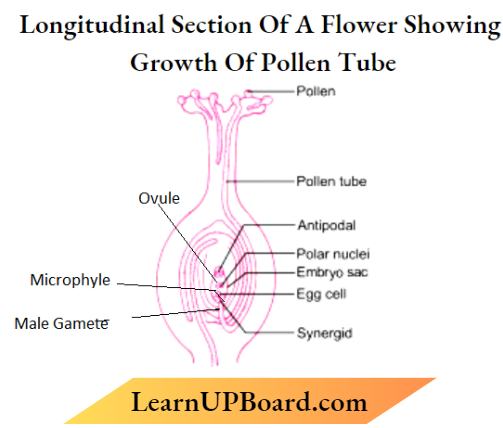
2. Write the function of micropyle.
Answer:
The pollen tube, after reaching the ovary, enters the ovule through the micropyle and then enters one of the synergids through the filiform apparatus.
Sexual Reproduction In Flowering Plants Long Question And Answers
Question 1. Study the figures given below of the development of megaspores in an angiosperm and answer the questions that billow :
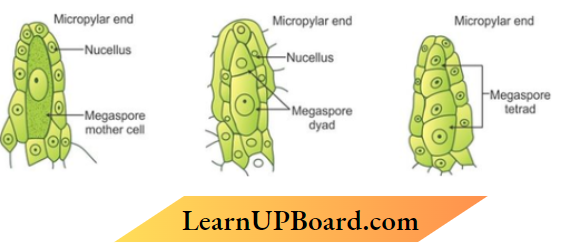
1. Describe the developmental events in the nucellus of the ovule. What is this type of development of megaspore referred to as?
Answer:
- Enclosed within the integuments is a mass of cells called the nucellus.
- Cells of the nucellus have abundant reserve food materials.
- Located in the nucleus is the embryo sac or female gametophyte.
- This method of embryo sac formation from a single megaspore is termed monosporic development.
2. How many free nuclear mitotic divisions will the functional megaspore undergo to form a mature embryo sac?
Answer:
3 mitotic division
3. Describe the structure of a typical female gametophyte of a flowering plant.
Answer:
- A characteristic distribution of the cells within the embryo sac.
- Three cells are grouped at the micropylar end and constitute the egg apparatus.
- The egg apparatus, in turn, consists of two synergids and one egg cell.
- The synergids have special cellular thickenings at the micropylar tip called filiform, apparatus, which plays an important role in guiding the pollen tubes into the syttergid.
- Three cells are at the chalazal end and are called the antipodal.
- The large central cell, as mentioned earlier, has two polar nuclei.
- Thus, a typical angiosperm embryo sac. at maturity, though 8-nucleate is 7-celled.
Question 2:
1. Name the specific part of the anther and the process responsible for the development of a male gametophyte in an angiosperm.
Answer:
porogenous tissue or Microsporungium Microspore mother cell Pollen mother cell or PMC Microsporogenesis.
2. Draw a labelled diagram of a mature male gametophyte (3-celled) of an angiosperm. Write the functions of each labelled part
Answer:
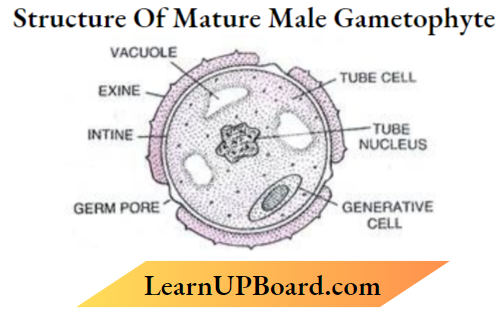
- Vegetative cell – It has an abundant food reserve
- Male gametes – Participate in double fertilisation or one male gamete fuses with the egg and the other fuses with two polar nuclei or secondary nucleus (any two)
- Exilic – Made up of the most resistant organic material sporopollenin or can withstand high temperatures or strong acids or alkalis or no enzyme can degrade it.
- In tine – Contributes pollen tube formation.
- Germ pore – Region from where pollen tubes arise.
Question 3. Explain the post-pollination events up to double fertilisation, that occur in an angiosperm.
Answer:
The Pollen grain germinates on the stigma to produce a pollen tube through one of the germ pores.
- The contents of the pollen grain or vegetative cell generative cell or two male gametes move into the pollen tube.
- The pollen tube grows through the tissues of the stigma and pollen tube to reach the ovary.
- The pollen tube enters (through micropyle) the synergids through the filiform apparatus, pollen tube releases two male gametes in the cytoplasm of the synergids.
- One of the male gametes fuses with the egg cell or female gamete completing syngamy. to form (diploid) zygote.
- The other male gamete fuses with two polar nuclei in the (central cell) to produce (a triploid) primary endospermic cell, three haploid cells fuse called triple fusion, and two types of fusion syngamy and triple fusion are called double fertilisation.
Question 4:
1. Describe any two devices in a flowering plant which pretend both autogamy and geitonogamy.
Answer:
Dioecy/production of unisexual flowers (in different plants) Self sterility or self-incompatibility or intraspecific incompatibility lists is a genetic mechanism and prevents self pollen (front the same flower or another flower of the same plant) from fertilising the ovules by inhibiting pollen germination or pollen tube growth in the pistil.
2. Explain the events up to double fertilisation after the pollen tube enters one of the synergids in an ovule of an angiosperm.
Answer:
Pollen tube releases 2 male gametes in the cytoplasm of synergid
- One male gamete fuses with egg cells or syngamy. resulting in a diploid zygote
- Other male gamete fuses with polar nuclei or triple fusion, to form diploid PEN (Primary Endosperm Nucleus) or PEC (Primary Endosperm Cell)
Question 5:
1. Draw a diagrammatic sketch of a transverse section of an anther of an angiosperm. Label its different walls and the tissue forming microspore mother cells.
Answer:

2. Describe the process of microsporogenesis up to the formation of a microspore.
Answer:
Sporogenous tissue → Microspore mother cell → Microspore tetrad
3. Write the function of germ pore1 in a pollen grain of an angiosperm.
Answer:
Germ pores allow the germinating or growing pollen tube with contents of the pollen grain or male gametes + vegetative cell to come out of the pollen grains
Question: 6
1. State one difference and one similarity between geitonogamy and xenogamy.
Answer:
GeitOnogamy – Transfer of pollen grains from the anther to the stigma of another flower of the same plant. Although is functionally cross-pollination involves 1 a pollination. agent, genet it ally it m similar to autogamy since the pollen grains come Item the sunn plant
Xenogamy – transfer of pollen grains from the anther to the stigma of a different plant This is the only tv[x of pollination which during pollination brings genetically different types of pollen grains to the stigma.
2. Explain any three devices developed in flowering plants to discourage self-pollination and encourage cross-pollination.
Answer:
Flowing plants have Haw developed many devices to discourage sell-pollination and to encourage cross-pollination.
- At some speed. pollen and base and stigma negativity are not synchronised.
- Lit her the pollen is released before the stima becomes receptive or stigma becomes receptive much before the release of pollen.
- In some other species, the anther and stigma are placed at different positions so that the pollen cannot come in contact with the stigma of the same flower.
